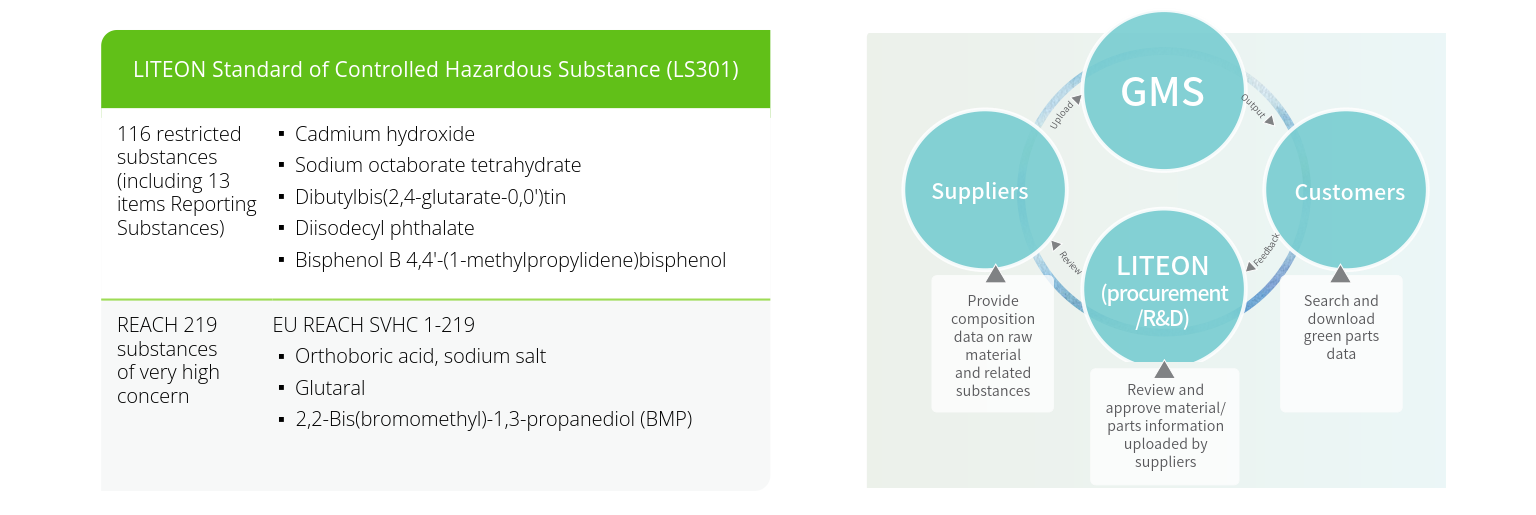Environment-Related Substances Management
In 2010, LITEON implemented the LITEON LS301 standards by following the IECQ QC
080000 system and taking into account the latest trends in other countries, regulations,
and customer needs. The LS301 standards apply to all products. The LS301 standards are
revised from time to time after calibration with different versions adopted by different
business units. The total number of restricted substances reached 564 in 2022.
The in-house Green product Management System (GMS) works with the "restricted
substances management" and " design development management" procedures already
in place as well as the LS301 standards for hazardous substance management. LITEON
also requires that suppliers (including contractors) comply with the LITEON Guidelines
for Green Procurement and submit the Supplier Statement of Restricted Substances
Compliance for material/part acknowledgment and internal control. Furthermore, LITEON states explicitly in all procurement contracts the strict requirement for materials, parts, or semi-finished goods to comply with or exceed RoHS, REACH, California Proposition 65, and Montreal Protocol. Among them, LITEON has set the goal to reduce the halogen concentration in the products by 2025, including CL<700 ppm, Br<500 ppm, and CL+Br<1000 ppm. With the implementation of green supply chain management, we
hope to achieve the goal of sourcing environmentally friendly materials, manufacturing
and providing to our customers low-toxicity and low-pollution products to minimize any
harmful impact they may have on the human body or the environment.
LITEON installs the Green product Management System (GMS) to effectively manage and
review compliance with the LS301 criterion for raw materials, parts, or semi-finished
goods provide by the suppliers. GMS combines material requirements, international
laws, international directives, customer policies, and supplier information. Suppliers file
product testing and analysis results for the system to determine automatically whether
they comply with the rules and directives. LITEON will summarize and analyze the data,
and check the degree of compliance with the LS301 standards. Furthermore, GMS not
only actively delivers information on green product management at LITEON to customers,
but also feeds environmental requirements or provisions for green products, such as ErP,
WEEE, and 3R, from customers into the management system to provide a basis for green
product design.
LITEON made a running change to replace materials, parts, and modules containing diisobutyl phthalate (DIBP). The substance ceased to be used in any of the products in January 2019.

VOC Emission Manegement
Volatile organic compounds (VOCs) emitted at LITEON come mainly from organic solvents used during production, such as soldering flux and isopropanol
vapors. NOx and SOx emissions from generators used for emergency or testing in the plants and from hot water boilers in the living area are considered
trace amounts. LITEON manages VOC emissions through management styles, procedure improvement, training, and regular third-party inspection. In
addition, LITEON started implementing stronger outdoor air pollution emission controls on site in 2017.
Inspection data from the plants, actual factory
conditions and local environmental policies were considered in the design of comprehensive and reasonable emission treatment systems with two levels or
more (e.g., precipitators, UV photocatalysis, and activated carbon-based absorption). We carried out different reduction measures in the operating plants,
such as waste collection and treatment transformation, use of clean products with low VOCs emissions, switch to coatings with low VOCs emissions, etc.,
to reduce the amount from source to discharge treatment measures. These systems were built to fulfill a comprehensive purpose including removing VOC
pollutants, optimizing control, reducing consumption, and ensuring safety. VOC emissions at LITEON are calculated according to the test data of third-party
environmental compliance inspection reports and hours of operation. The report is lower than the VOCs emission standard value set by each region, and
continues to reduce VOCs emissions. The total emissions reported from LITEON's main manufacturing bases worldwide were 19.7 tons in 2022.
Note: Emission data includes Changzhou, Tianjin, Huizhou, Dongguan and Guangzhou in a total of 8 production sites.
Environmental Sustainability ▸
Select Language


